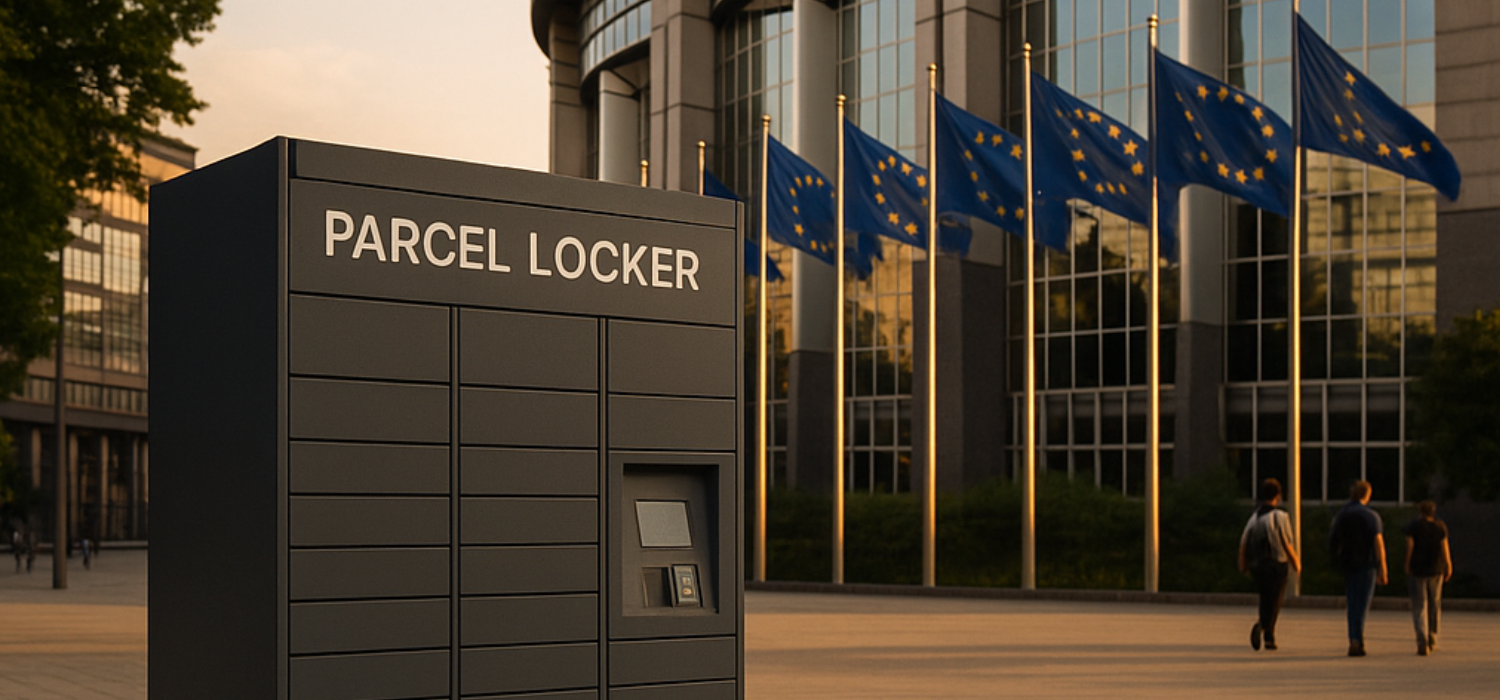Parcel lockers are now a structural component of urban logistics. They allow deliveries to be consolidated, reduce failed attempts and cut down on the kilometres travelled by vans, thus reducing the environmental impact of e-commerce and urban traffic.
However, significant results in terms of reducing emissions can only be achieved through dense, well-located networks that are integrated into the urban fabric.
We have already discussed the importance of the strategic location of lockers in order to optimise the advantages of this delivery method, but positioning lockers also means having to deal with rules, permits and fees. In other words, with the regulatory framework that allows them to be installed on public land.
In a context where e-commerce continues to grow and put pressure on the last mile, local authorities have to manage more vehicles, more stops and more land use, with repercussions on congestion, safety and the liveability of urban centres. Clear regulations for lockers therefore become an enabling tool: they protect decorum and accessibility, reduce emissions and promote interoperable models instead of fragmented networks.
But what is the state of the art in locker regulation in Europe? How are the major cities moving forward? And, above all, what does Italy need today to make a quantum leap? Read on to find out.
What is a parcel locker, in regulatory terms?
In regulatory terms, parcel lockers are automatic lockers for the delivery and collection of parcels, usually located in high-traffic areas such as stations, transport hubs and shopping centres, accessible 24/7.
Where they fit in the law
At European level, there is no specific legislation on lockers: they fall within the general framework of postal services and, above all, local rules governing the use of public space.
In Italy, when a locker is installed on public land or on private land that is accessible to the public, a land occupancy permit is required and the Single Property Tax introduced by Law 160/2019 applies, with the terms and amounts defined by municipal regulations. In practice, the local authority issues the permit and sets the conditions, duration and fee.
When lockers are located on private property (e.g. inside or outside a commercial or residential building), however, the installation is subject to the building and safety regulations applicable to the building and the space in which it is located; the contractual obligations between the owner/manager of the area and the service operator remain unchanged. Even in this scenario, the national policy has recognised the usefulness of simplifying and standardising procedures, precisely in order to promote the orderly spread of this infrastructure.
Technical reference standards
Although urban planning regulations are local, the technical basis is harmonised at European level. The CEN/TS 16819:2015 specification describes the technical characteristics of parcel boxes for end use (useful dimensions, ergonomics and safety, resistance to corrosion and water penetration, delivery security), providing a reference used by administrations and operators when drawing up guidelines or specifications. This is complemented by CEN/TS 17073:2020, which covers secure opening systems for parcel boxes and letterboxes, with a particular focus on electronic authentication of operators. More recent technical documents – such as CEN/TR 18085:2024 on secure and contactless delivery – also reflect the evolution of delivery practices and proof of delivery requirements.
Why this framework is useful for operators
This combination of local rules on public space and European technical specifications clarifies who does what. In practical terms, local authorities govern where and how a locker can be installed (permits, fees, urban integration and accessibility requirements), while CEN standards help define what the device must guarantee in terms of safety, reliability and ergonomics.
For merchants, couriers and locker network operators, this means being able to plan investments with greater certainty, communicating with local authorities on a verifiable and shared basis.
Overview of regulations in Europe
Once it has been clarified who does what, the next step is to see how this framework translates into practice. Many European cities have already begun to put rules in place, each with different tools (land use permits, aesthetic guidelines, trials in transport areas, and even multi-operator models). Our overview of current regulations in Europe is based on Andre V. Veskimeister’s mapping, which we used as a starting point to provide an up-to-date and comparable picture.
The aim, of course, is not to draw up a ranking, but to understand how this phenomenon is being regulated. In the following sections, we look at each city individually, highlighting the elements that can be replicated and the critical issues to be avoided for those operating in the e-commerce and logistics supply chain.
Bratislava: rules on location, aesthetics and ‘visual smog’
In July 2025, the City of Bratislava, Slovakia, defined rules on the size, location and appearance of lockers in public spaces, with authorisation procedures and attention to the issue of ‘visual smog’. Installations on public land are subject to permits, fees and urban integration criteria. The city has published a dedicated handbook to discourage the improper occupation of pavements and parks.
Kraków: lockers as ‘occupation of the road’
In Kraków, Poland, the management of devices on public land, including lockers, falls under the jurisdiction of the Zarząd Dróg Miasta Krakowa (ZDMK) and follows the procedure for the occupation of roadways with temporary permits and fees based on surface area and location. The official pages illustrate the criteria, forms and fees due, which also apply to structures such as paczkomaty (parcel lockers) when located on road property.
Poznań and Wrocław: specific municipal guidelines
Some Polish cities have also published explicit guidelines. The city of Poznań, for example, issued operational and urban planning guidelines for the placement of lockers on municipal land in 2021, while the city of Wrocław updated a technical document in 2024/2025 detailing requirements for location, accessibility and landscape integration. These are ‘valid’ acts on municipal land, but they also represent useful benchmarks for other authorities.
Berlin, Tempelhof-Schöneberg district: ‘Sondernutzung’ and suitable areas
In the Berlin district of Tempelhof-Schöneberg, lockers are classified as ‘special use’ of road space (“Sondernutzung”) and regulated by a Merkblatt (i.e. a technical or informational document) that defines permissible areas, discourages installation on narrow pavements and in parks, and encourages solar-powered solutions in mobility hubs, in line with climate and accessibility objectives.
Stockholm: restrictions in the historic centre and priority for pedestrian safety
In Stockholm, Sweden, the Trafikkontoret (Department of Transport) has adopted a cautious approach in historic areas: the city has made clear its intention to ban the installation of lockers within 300 metres of the inner city perimeter in order to protect the character of the area, preserve the use of pavements and reduce clutter in sensitive contexts. Official documents and policy reports illustrate the administration’s orientation and the local conditions (distances, aesthetic compatibility, pedestrian accessibility).
London: trials in boroughs and partnerships with TfL
In London, several boroughs have launched pilot programmes on municipal land, often favouring off-pavement sites and networks that can be used by multiple couriers. The borough of Hounslow, for example, has launched a ‘multi-borough’ pilot with YEEP! Lockers, together with the boroughs of Lambeth, Merton, Kingston and Sutton, motivated by environmental and traffic reduction objectives. At the same time, Transport for London has installed ‘click & collect’ lockers in over 50 station car parks, thereby consolidating deliveries and reducing the number of kilometres travelled for failed attempts.
Vienna: public platform and transport area trials
In Vienna, the Wiener Stadtwerke group has developed the WienBox project for a network of lockers serving the city, while WienIT (a group company) presented Nextbox in 2025, a ‘white-label’ platform for interoperable networks, designed for administrations and operators. The Viennese framework is also interesting because it combines widespread public property (transport, housing, parks) and building constraints: the guidelines and building references focus on materials, fire safety and specific rules for installations in historic residential buildings.
Beyond regulations: guidelines that empower cities
Not all jurisdictions have ad hoc regulations, but there are handbooks and guidelines for municipalities. In the Netherlands, for example, studies promoted by Topsector Logistiek have produced a ‘handreiking’, i.e. a practical guide to integrating lockers and collection points into urban planning, with recommendations on location, interoperability and impacts on public space. Although not binding, these materials fill regulatory gaps and promote consistent approaches between cities.
Outside Europe: the most interesting cases
Looking overseas, New York City has launched the LockerNYC pilot: lockers on public pavements, free for users and open to multiple couriers with strict rules on maintenance, security and data collection to assess impacts on theft, efficiency and congestion. The programme was launched in 2024 and has already been expanded several times.
Singapore, in Asia, is an example of an open-access national network: the IMDA authority has established and regulated the Pick Network, with 1,000 stations in transport hubs and residential neighbourhoods, ensuring fair access for all carriers and standardising rules, interfaces and security through an interoperable platform. For those designing locker networks in Europe, this case is certainly a reference point in terms of governance, neutrality and scalability.
Italy: where we are and what is missing
In Italy, there is currently no specific national law for parcel lockers on public land. As mentioned above, installations fall within the general framework of public land occupation and the Single Property Tax (established by Law 160/2019), which municipalities apply with their own regulations. In practice, a concession is required for occupation, fees are paid based on surface area, duration, type and zone, and all road safety and street furniture regulations apply; in historic areas, landscape restrictions also apply. It is a system that works, but it creates procedural variability and timescales that are not always predictable.
AGCOM – the Italian Communications Authority – has recognised the role of lockers in the postal market, defining their characteristics and highlighting the usefulness of harmonising local regulations to simplify authorisation procedures and encourage the development of networks in areas open to the public and in apartment buildings. Although not an urban planning regulation, these acts indicate a clear direction: greater certainty and uniform rules to accelerate investment.
Many Italian cities already integrate lockers into their mobility hubs or urban logistics strategies. Rome, for example, has partnered with ATAC to install InPost and Amazon lockers in metro stations, taking advantage of interchange spaces and reducing travel distances to homes. Postal companies and couriers have also developed extensive private networks in commercial and private areas, such as Poste Italiane with its Punto Poste network.
The four pillars of European locker policy
The experiences mentioned above highlight four recurring objectives:
- Order and decorum: limiting the ‘crowding’ of lockers on narrow pavements and ensuring special protection in historic centres, as well as aesthetic and colour requirements.
- Accessibility and safety: ensuring pedestrian walkways (i.e. the free and continuous width of the pavement that must remain free of obstacles to allow people, including users with pushchairs, aids or wheelchairs, to pass safely and comfortably), ramps, visibility and clear paths, complying with hardware ergonomics and safety standards.
- Decarbonisation: dense networks, integrated with local public transport hubs and powered by solar energy, as well as a combination of lockers with cargo bikes and micro-hubs.
- Interoperability: the most promising trend is to push for multi-operator networks or neutral platforms that open lockers to multiple couriers, avoiding duplication of infrastructure.
The essential elements of good ‘locker-ready’ regulation
The European experiences analysed reveal a fairly clear recipe: measurable criteria are needed for where to install lockers, simple procedures for authorising them, accessibility standards for safe use, neutrality to avoid duplicate networks and, finally, data to correct the course.
Looking beyond regulation, operators and merchants can also play an essential role in facilitating the shift to out-of-home by offering the locker option at checkout and communicating the environmental and reliability benefits to customers in a transparent manner.
In this scenario, GEL Proximity acts as a neutral enabler: a single platform that orchestrates multi-operator networks and collection points, helps merchants, couriers and administrations to comply with local regulations, optimises the allocation of the locker closest to the user and measures results with operational metrics on collections, failed deliveries, average times and CO₂ emissions.
Want to understand how to integrate lockers into your checkout or design a compliant and high-performance proximity network? Talk to our team!












